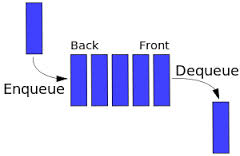Data Structure Summary
Linked List
LinkedList − A Linked List contains the connection link to the first link called First and to the last link called Last.
Singly Linked List
A singly linked list is a set of nodes where each node has two fields ‘data’ and ‘link’. The ‘data’ field stores actual piece of information and ‘link’ field is used to point to next node.
Doubly Linked List
A doubly linked list contains an extra pointer, typically called previous pointer, together with next pointer and data which are there in singly linked list.
Difference between Singly linked list and Doubly linked list
| In SingleLinkList, the traversal can be done using the next node link only. | In DoublyLinkList, the traversal can be done using the previous node link or the next node link. | |
| The SingleLinkList occupies less memory than DoublyLinkList as it has only 2 fields. | The DoublyLinkList occupies more memory than SingleLinkList as it has 3 fields. | |
| Less efficient access to elements. | More efficient access to elements. |
Stack
A stack is a linear data structure in which elements can be inserted and deleted only from one side of the list, called the top. A stack follows the LIFO (Last In First Out) principle. The insertion of an element into stack is called push operation, and deletion of an element from the stack is called pop operation. In stack we always keep track of the last element present in the list with a pointer called top.

Queue
A queue is a linear data structure in which elements can be inserted only from one side of the list called rear, and the elements can be deleted only from the other side called the front. The queue data structure follows the FIFO (First In First Out) principle, i.e. the element inserted at first in the list, is the first element to be removed from the list. The insertion of an element in a queue is called an enqueue operation and the deletion of an element is called a dequeue operation.

Expression Parsing
Infix Notation
We write expression in infix notation, a - b + c, where operators are used in-between operands. It is easy for us humans to read, write, and speak in infix notation but the same does not go well with computing devices. An algorithm to process infix notation could be difficult and costly in terms of time and space consumption.
Prefix Notation
In this notation, operator is prefixed to operands,operator is written ahead of operands. For example, +ab. This is equivalent to its infix notation a + b. Prefix notation is also known as Polish Notation.
Postfix Notation
This notation style is known as Reversed Polish Notation. In this notation style, the operator is postfixed to the operands, the operator is written after the operands. For example, ab+. This is equivalent to its infix notation a + b.
Hashing
Hashing is a technique to convert a range of key values into a range of indexes of an array.
Hash Table
Hash table is a data structure that represents data in the form of key-value pairs. Each key is mapped to a value in the hash table. The keys are used for indexing the values/data. A similar approach is applied by an associative array.
Basic Operations
Following are the basic primary operations of a hash table.
- Search − Searches an element in a hash table.
- Insert − inserts an element in a hash table.
- delete − Deletes an element from a hash table.

Full Binary Tree
Full Binary Tree is a Binary Tree in which every node has 0 or 2 children.
Complete Binary Tree
Complete Binary Tree has all levels completely filled with nodes except the last level and in the last level, all the nodes are as left side as possible.
Perfect Binary Tree
Perfect Binary Tree is a Binary Tree in which all internal nodes have 2 children and all the leaf nodes are at the same depth or same level.
Balanced Binary Tree
Balanced Binary Tree is a Binary tree in which height of the left and the right sub-trees of every node may differ by at most 1.

Very helpful, thanks
ReplyDelete